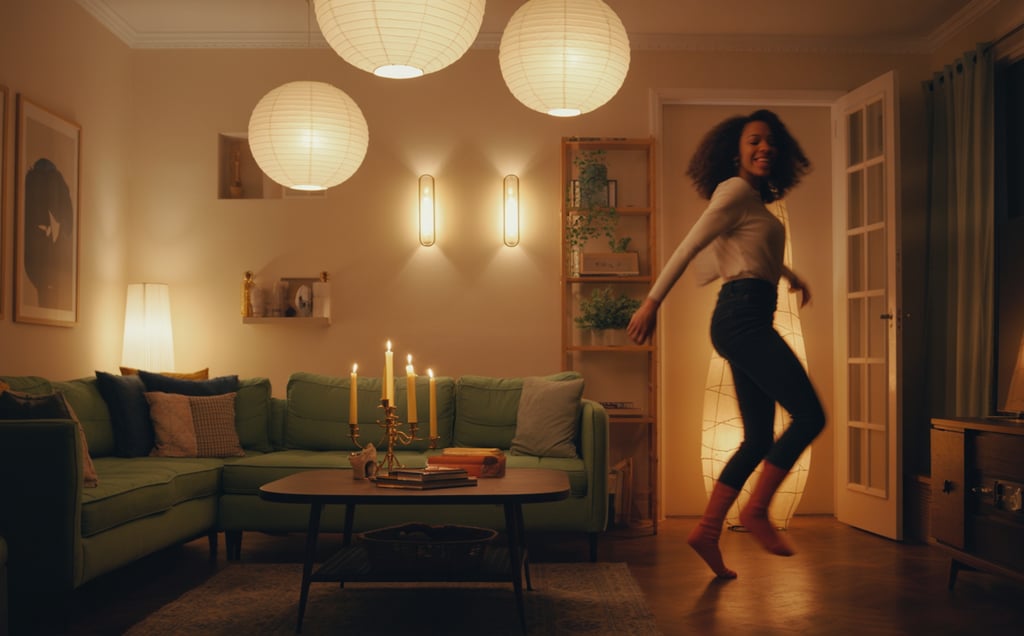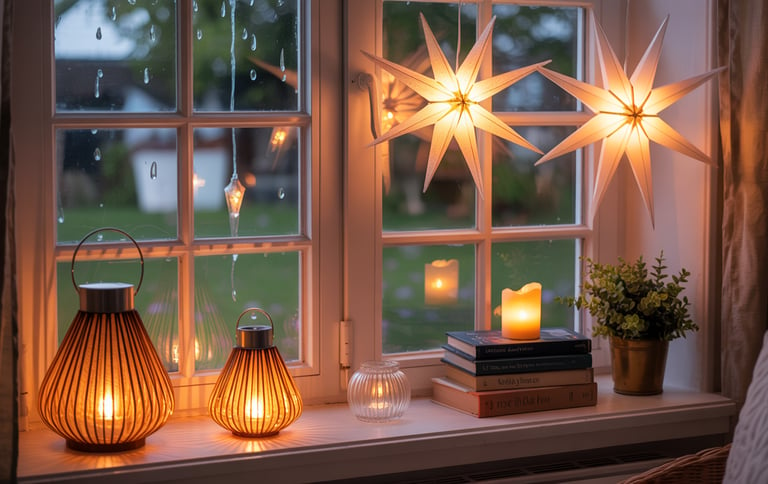Mood Lighting, Textures & Intention: The Formula for Cozy Living Rooms
HOME DECOR
FONNI
7/25/202510 min read


The content on this site was created with the help of AI. LOVEOWE LLC participates in the Amazon Services LLC Associates Program and other affiliate programs. As an Amazon Associate, I earn from qualifying purchases. This means I may earn a small commission—at no extra cost to you—when you make a purchase through links on this site. All opinions are my own. Learn more click here. Thank you for your support!
Creating a cozy living room goes beyond mere aesthetics. It's about crafting a space that wraps you in warmth and comfort. Through years of exploring home decor, I've learned that specific elements are crucial.
Experts highlight the importance of mood lighting and textures in achieving coziness. When combined with a clear intention, your living room can become a cozy haven, akin to a warm hug.
As we dive into cozy living rooms, we'll see how these elements combine to create a welcoming space. Understanding their role will help you envision your perfect cozy living room.
The Science of Coziness: Understanding What Makes a Space Feel Warm
Creating a cozy living room goes beyond design; it's about crafting a space that wraps you in warmth and comfort. We explore the science behind coziness, revealing the psychological and design elements that make a space welcoming.
Psychological Elements of Comfort
Comfort is deeply rooted in psychology. A cozy space often brings feelings of safety, relaxation, and togetherness. To achieve this, consider elements that promote emotional warmth, such as family photos, soft textiles, and warm lighting.
The Danish Concept of Hygge and Its Application
The Danish concept of hygge (pronounced hoo-gah) highlights the value of warmth, comfort, and togetherness. To apply hygge to your living room, focus on creating a snug atmosphere with candles, soft blankets, and warm color palettes.
Balancing Visual Weight in Your Space
A well-balanced space is key for coziness. Balance visual weight by distributing elements like texture, color, and furniture thoughtfully. For example, pair heavy furniture with lighter textiles or bold colors with neutral backgrounds.
By understanding these elements, you can create a cozy living room that feels warm and inviting. It's perfect for relaxing and connecting with loved ones.
Mood Lighting, Textures & Intention: The Secret Formula for Cozy Living Rooms
The secret to a cozy living room is found in the perfect mix of mood lighting, inviting textures, and thoughtful intention. As we dive into this formula, you'll see how these elements combine to create a space that feels warm and welcoming.
How These Three Elements Work Together
Mood lighting, textures, and intention are interconnected. When balanced, they create a cozy atmosphere. For example, soft lighting enhances the warmth of plush textures. Intentional design ensures these elements serve more than just aesthetic purposes.
Mood lighting sets the emotional tone of the room.
Textures add depth and tactile experience.
Intention gives purpose and meaning to the space.
The Transformative Power of Intentional Design
Intentional design is about creating a space that nurtures and comforts. By carefully selecting and arranging elements, you can turn your living room into a sanctuary. It becomes a place that supports relaxation and connection.
Assessing Your Current Living Room's Cozy Potential
To gauge your living room's cozy potential, evaluate your mood lighting, textures, and design intentions. Ask yourself:
Is my lighting adjustable and warm?
Are there varied textures that invite touch?
Does my space feel purposeful and comfortable?
Layering Light: The Foundation of a Cozy Atmosphere
The essence of a cozy living room is in the art of layering light. It's not merely about lighting up the space. It's about creating a warm, welcoming ambiance that invites relaxation and comfort.
Ambient, Task, and Accent Lighting Explained
Understanding the three main lighting types is crucial for a cozy atmosphere. Ambient lighting sets the overall mood, task lighting focuses on specific areas, and accent lighting highlights decorative elements or adds visual interest.
Selecting the Right Fixtures for Each Layer
For ambient lighting, ceiling fixtures or table lamps with soft shades are ideal. Task lighting can be achieved with desk lamps or under-cabinet lighting in kitchens. Accent lighting often involves spotlights or floor lamps to draw attention to specific features.
Creating Depth Through Light Variation
Varying light levels and sources adds depth and visual interest to your living room. Mixing different light sources prevents a flat, one-dimensional look. This creates a cozy, layered ambiance.
Step-by-Step Guide to Mapping Your Lighting Plan
To map your lighting plan, start by identifying areas for task lighting. Then, add ambient lighting to fill in the gaps. Lastly, incorporate accent lighting to highlight your favorite features or decorative pieces. This layered approach will help you achieve a cozy, inviting atmosphere in your living room.
Mood Lighting Techniques for Maximum Comfort
Lighting is a key element in making a living room feel like home. The lighting in our spaces can greatly influence our mood and comfort. We will explore mood lighting techniques to enhance comfort in your living room.
Warm vs. Cool Light: Choosing the Right Color Temperature
The color temperature of your lighting significantly impacts your living room's ambiance. Warm light, between 2700K-3000K, creates a cozy atmosphere, ideal for living areas. Cool light (3500K-5000K) is more energizing, suited for task-oriented spaces like kitchens or home offices.
Dimmers and Smart Lighting Systems: Installation and Use
Dimmers and smart lighting systems provide unmatched flexibility in adjusting lighting for various moods and activities. Installing dimmers is straightforward, involving replacing existing light switches with dimmer switches. Smart lighting systems can be controlled via apps or voice assistants, making it easy to adjust lighting levels and color temperatures.
Strategic Placement for Optimal Ambiance
The placement of light sources is vital for creating a cozy ambiance. Table lamps, floor lamps, and string lights can create warm light pools, adding depth and interest. Place lights at different heights and distances for a layered lighting effect.
Creating Lighting Zones in Open Floor Plans
In open floor plans, distinct lighting zones help define areas. Use overhead lighting, table lamps, and floor lamps to create zones for reading, watching TV, or socializing. This approach improves space functionality and enhances coziness.
The Texture Playbook: Adding Dimension to Your Living Space
Textures are the unsung heroes of interior design, working behind the scenes to create a warm and welcoming atmosphere. When we think about making our living rooms cozy, we often focus on lighting and color. Yet, texture plays an equally crucial role in creating a space that feels inviting and comfortable.
Soft Textures: Throws, Pillows, and Upholstery
Soft textures are essential for adding warmth and coziness to a room. Throws, pillows, and upholstered furniture are not just decorative elements; they invite touch and make a space feel more intimate. When selecting soft textures, consider materials that are pleasant to the touch, such as velvet, linen, or chunky knits.
Velvet pillows for a luxurious feel
Chunky knit throws for a cozy vibe
Linen upholstery for a soft, natural look
Hard Textures: Wood, Metal, and Stone Elements
Hard textures provide a beautiful contrast to soft elements, adding depth and visual interest to your living room. Wood, metal, and stone elements can be incorporated through furniture, decor, or architectural features. For example, a wooden coffee table or a metal sculpture can add a touch of sophistication, while a stone fireplace can become a cozy focal point.
Mixing Textures for Visual Interest
Mixing different textures is a powerful way to add dimension to your living space. The key is to strike a balance between contrasting textures. For instance, pairing a soft, velvet sofa with a rough, wooden coffee table can create a visually appealing contrast.
The Rule of Three for Texture Combinations
A helpful guideline for mixing textures is the rule of three. This involves combining three different textures in a way that creates harmony. For example, you could pair a soft throw blanket with a wooden side table and a metal vase. The rule of three allows for creativity while maintaining balance.
Choose a dominant texture (e.g., a large, upholstered sofa)
Add a secondary texture (e.g., a wooden coffee table)
Incorporate an accent texture (e.g., a metal or glass decorative piece)
By thoughtfully incorporating a mix of textures, you can create a living room that feels layered, inviting, and truly cozy.
Designing with Intention: Creating Purposeful Living Areas
Intentional design transcends mere furniture arrangement; it crafts spaces that enhance daily life and foster connection. By designing with purpose, we create areas that are not only aesthetically pleasing but also serve a functional and meaningful role.
Defining Your Living Room's Primary Functions
Reflect on your living room's primary use before rearranging. Is it for unwinding, entertainment, or as a workspace? Identifying its main functions will steer your design choices. For instance, if you frequently host events, focus on seating and conversation areas. If you work from home, a dedicated workspace within the room might be essential.
Arranging Furniture for Conversation and Connection
The layout of your furniture greatly influences your living room's atmosphere. To foster conversation and connection, consider a circular seating arrangement. Even small tweaks, like adjusting the sofa's angle, can significantly enhance the space. The aim is to foster a sense of unity and fluidity.
Creating Activity Zones Within One Space
In today's urban environments, spaces must serve multiple purposes. By dividing your living room into activity zones, you can achieve this. For example, include a reading nook, a TV area, and a workspace. Use rugs, lighting, and furniture placement to subtly define these zones. This strategy not only optimizes space but also adds visual appeal.
By embracing these intentional design principles, you can transform your living room into a space that is both functional and inviting. It will meet your needs and enrich your lifestyle.
Color Psychology: Selecting Hues That Enhance Coziness
The right color palette can transform a living room into a cozy retreat. Understanding how colors affect our perception of space is key. We'll explore color psychology to find hues that create a cozy atmosphere.
Warm vs. Cool Color Palettes
Warm colors, like red, orange, and yellow, make spaces feel cozier than cool colors, which include blues and greens. Warm colors evoke warmth and comfort, leading to feelings of relaxation.
Creating Color Harmony
To achieve a harmonious color scheme, follow the 60-30-10 rule. Use 60% of a dominant color, 30% of a secondary color, and 10% of an accent color. This balance enhances visual appeal.
Choose a dominant warm color for the walls.
Use a secondary color for furniture and textiles.
Add an accent color with decorative items.
How to Test Paint Colors
Testing paint colors under various lighting conditions is essential. Paint samples on the walls and observe their appearance at different times. This ensures the chosen hue enhances the space's coziness.
Small Space Solutions: Making Compact Living Rooms Feel Cozy, Not Cramped
Turning a small living room into a cozy retreat requires careful design choices. We grasp the challenge of maximizing limited space while fostering a warm, inviting ambiance.
Scale-Appropriate Furniture
Choosing the right furniture is key in small spaces. Opt for pieces that match the room's scale. Sleek, low-profile sofas and armchairs are ideal, as they don't overwhelm the area.
Select furniture with legs or slim bases to create a sense of openness.
Avoid bulky pieces that can make the room feel cramped.
Visual Tricks to Expand Small Spaces
Visual tricks can make small spaces appear larger. Strategically placing mirrors can reflect light and create the illusion of more space.
Place mirrors opposite windows to reflect natural light.
Use light colors on walls to create a sense of expansiveness.
Multi-functional Pieces
Incorporating multi-functional furniture can boost the coziness of small living rooms without sacrificing comfort. Look for pieces like storage ottomans or coffee tables with storage.
Choose furniture that serves more than one purpose.
Consider nesting tables that can be easily stored when not in use.
By applying these strategies, you can turn even the smallest living room into a cozy, welcoming space. It becomes a perfect spot for relaxation and socializing.
Seasonal Adjustments: Transitioning Your Cozy Space Throughout the Year
As seasons shift, our homes can feel outdated. Yet, with a few tweaks, we can maintain a cozy vibe year-round. The trick lies in making thoughtful changes that mirror the season's light, temperature, and our evolving needs.
Winter Warmth
Winter beckons us with its warmth and coziness. Achieving this is simple: opt for warm lighting, plush blankets, and luxurious fabrics like wool and velvet. Here are some quick tips for a warm winter atmosphere:
Employ warm-toned lighting, like table lamps or floor lamps with warm shades.
Introduce plush throw blankets and pillows in rich textures like wool and velvet.
Include natural elements, such as pinecones and evergreen branches, in your decor.
Summer Comfort
Summer, on the other hand, demands a lighter, brighter ambiance. To achieve this, opt for cool-toned lighting, lightweight fabrics, and natural elements like plants and flowers. Here are some tips for a summer-friendly space:
Choose cool-toned lighting, such as string lights or LED candles.
Switch to lightweight fabrics, like cotton and linen.
Introduce natural elements, like potted plants and vases of fresh flowers.
Creating a Versatile Base Design
For easier seasonal transitions, a versatile base design is crucial. Opt for timeless furniture and decor, and a neutral color palette. This allows for easy seasonal updates with the right accessories.
With a few simple decor and lighting adjustments, we can ensure our cozy atmosphere remains vibrant all year, regardless of the season.
Budget-Friendly Approaches to Creating a Cozy Living Room
Making your living room cozy and welcoming doesn't have to be expensive. Here are some budget-friendly tips.
DIY Lighting Projects Anyone Can Complete
DIY lighting projects can significantly impact your living room's ambiance. Consider making your own lamp shades or string lights. This adds a personal touch.
Thrifting for Textural Elements
Thrifting is a great way to find unique textural elements for your living room. Look for vintage throws, pillows, and rugs. They add depth and coziness.
Low-Cost, High-Impact Changes
Making low-cost changes can greatly enhance your living room's coziness. This includes rearranging furniture, adding plants, or using candles for warm lighting.
Rearranging What You Already Own
One of the most cost-effective ways to refresh your living room is by rearranging furniture and decor you already own. Experiment with different layouts. Find one that promotes coziness and conversation.
Common Mistakes to Avoid When Creating a Cozy Living Space
Designing a cozy living space requires avoiding common pitfalls. A well-designed cozy living room balances and is intentional. It's all about creating a welcoming atmosphere.
Overdoing It: Finding Balance in Cozy Design
One major mistake is over-accessorizing, which can clutter and overwhelm a room. To prevent this, choose a few statement pieces. These should add warmth and texture to your space.
Neglecting Personal Style for Trends
Following the latest trends can make a space feel impersonal. Instead, include elements that reflect your personal style. This way, your cozy atmosphere will feel authentic and true to you.
Ignoring the Importance of Negative Space
Negative space is key to creating calm and coziness. Ensure your design includes some breathing room. This prevents a cluttered feel and enhances the overall coziness.
Forgetting About Maintenance and Practicality
A cozy living room must be both beautiful and functional. Consider the maintenance needs of your design. This ensures your space remains comfortable and inviting over time.
Conclusion: Bringing Your Cozy Living Room Vision to Life
Our journey to create a cozy living room has shown us the importance of mood lighting, textures, and intention. These elements can turn any space into a warm, inviting haven. By incorporating them, you can make your living room a reflection of your style and a comfortable retreat from the world.
To bring your vision to life, begin by assessing your current space and identifying areas for improvement. Think about the ambiance you desire and how lighting, textures, and design can help achieve it. With creativity and planning, your living room can become a cozy oasis. Home styling is about making a space feel like home. With these tips, you're on the path to creating a cozy living room you'll cherish.


